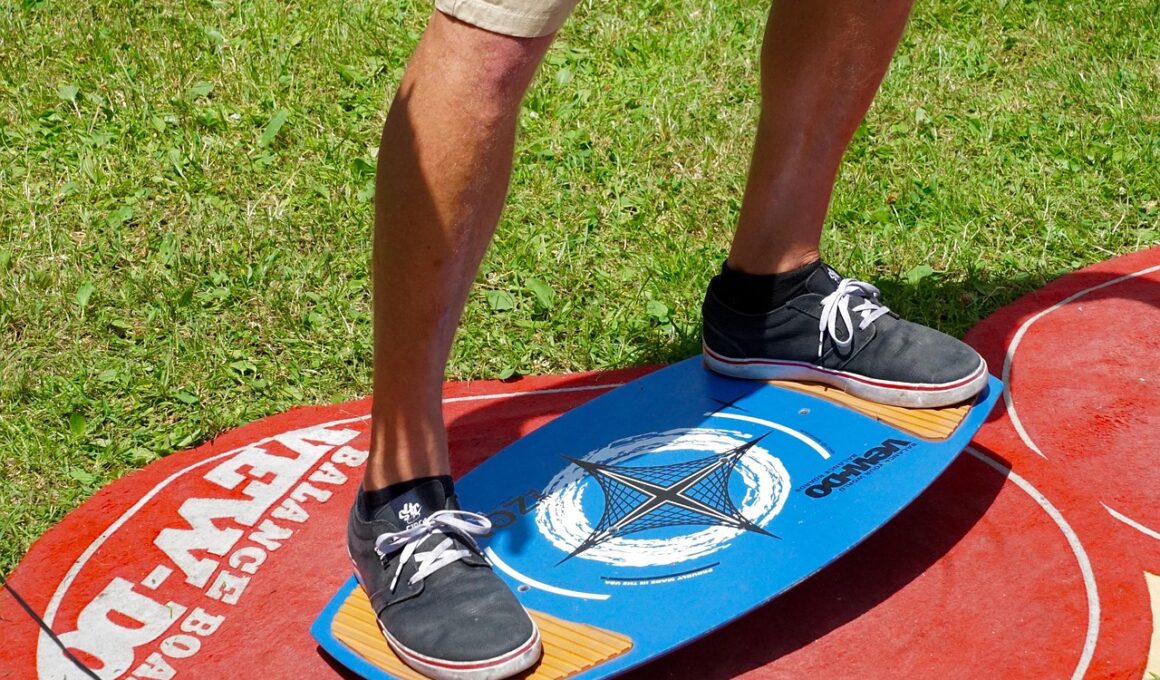Choosing the Right Balance Board for Your Fitness Level
When embarking on your journey with balance boards, the first step is considering your current fitness level. A beginner should prioritize stability and control in their choice. Many boards are designed specifically for beginners, featuring larger bases and softer materials that enhance grip. As you become more comfortable, you might explore other options such as wobble boards or rocker boards to increase difficulty. Engaging in any balance training requires a clear understanding of your physical abilities and limitations. Caution is critical during this process to prevent injury. It’s essential to read product specifications and take note of user reviews before purchasing. Regular use will not only improve your balance but also enhance your overall coordination and strength. If you’re unsure which board will suit your needs best, consult a fitness professional for tailored advice. Training on a balance board can significantly aid in physical therapy, rehabilitation, or injury prevention, emphasizing the necessity of making an informed decision. Consider watching videos or reading guides to get a better look at how different boards function and to determine what feels most comfortable for you.
Types of Balance Boards to Consider
As you explore balance boards, understanding the various types available can significantly impact your training effectiveness. Balance boards come in several shapes and sizes, including traditional wobble boards, rocker boards, and more specialized designs, each catering to different skill levels. Wobble boards offer a circular base, allowing for multidirectional movement, making them great for beginners and advanced users alike. Rocker boards typically have a stable shape that allows front-to-back motion, making them simpler for newcomers. There are also inflatable balance boards that can be used on any surface and add an extra challenge as they shift. Some boards are designed to be more challenging, perfect for enhancing specific athletic skills. Selecting the right type is paramount to ensure that your workouts remain engaging and beneficial. Consider your goals: whether they include improving balance for sports or enhancing core stability. Before deciding, it’s helpful to test different boards at a fitness store or read comprehensive reviews to understand how each board functions. Think about how these factors affect your day-to-day life and feel empowered to make the most balanced choice.
Another crucial factor in choosing balance boards is their construction material. Most boards are made from wood, plastic, or a combination of materials. Wooden balance boards offer durability and a more traditional feel, suitable for both home and commercial use. However, they may vary in weight, which can impact portability. On the other hand, plastic boards are often lighter and come in various designs. They may not provide the same level of durability but are generally more affordable. When deciding on materials, consider your training environment. For example, if you intend to use the board outdoors, look for weather-resistant options. If you’re in a physical therapy setting, stability is vital. Additionally, grip surface is essential for safety, particularly during intense workouts. Boards with textured surfaces tend to provide better traction. Comfort is key, so invest time figuring out which material resonates with your workout style. Many websites and forums have valuable insights on both the pros and cons of various materials. Ultimately, choose what feels best for you in terms of safety, durability, and aesthetic appeal.
Weight Limit Considerations
When selecting a balance board, understanding the weight limit is fundamental to ensure your safety and maximize the board’s usability. Most boards have specific weight ranges to maintain stability and prevent breakage. It’s crucial to verify the product specifications before making a purchase. Be mindful that exceeding this limit can lead not just to product damage but also to injuries like falls or sprains. If you fall within the average weight range, choosing a board won’t be too challenging; however, those above typical limits must be more discerning. Several brands offer specially designed boards that accommodate higher weights without compromising stability and balance. Furthermore, consider your fitness goals while evaluating weight limits. Should you want to share the board with family or friends, it’s wise to choose one with a higher capacity. Look for reviews or testimonials from larger users to gauge how these boards perform under stress. Checking weight limits will ultimately provide you with a safer training experience. Ensure you take this factor seriously when investing in your fitness journey to prevent accidents or injuries.
Incorporating accessories can offer additional safety and expand the functionality of your balance board. Some boards come with extra features like resistance bands or cushioned attachments that enhance your workouts. If you’re new to balance training, using resistance bands can aid in stabilization and provide added support. Consider adding a foam pad or a thick mat if your board lacks grip, which will improve stability and comfort during workouts. Accessibility is essential, and customizing your board can be beneficial to adapt it according to your skill level. As you progress, changing the board’s accessories or adding weights will help elevate your experience. Always remember that safety should be a priority; having the right accessories can reduce the risk of slips or falls. Make sure the board and any accessories meet your needs and will not lead to increased challenges if you’re unprepared. Engaging in balance board training is rewarding, and enhancing your board with various accessories can keep exercises enjoyable and effective. Do research to find relevant accessories that will increase your confidence and proficiency.
Setting Goals for Balance Training
Establishing clear goals for your balance training is a strategic way to maintain motivation and track progress. Whether you are focusing on enhancing athletic performance, recovering from an injury, or improving overall stability, setting specific objectives is vital. Start by asking yourself what you hope to achieve from balance training. Are you looking to improve core strength, enhance coordination, or develop endurance? Write these goals down and create a workout schedule that will keep you accountable. Incorporate balance boards into existing workout regimes and gradually advance the level of difficulty. Assess your progress regularly to identify what works best and adjust when needed. Including a journal or note-taking system can help to monitor mechanics, repetitions, and feelings during balance exercises. By documenting milestones, you can celebrate achievements along the way. Setting goals allows you to develop a focused training routine. With each accomplishment, you’ll find renewed enthusiasm for your workouts and continue progressing on your fitness journey.
In conclusion, selecting the right balance board requires careful consideration of several factors, including your fitness level, the type of board suitable for your goals, materials, weight limits, accessories, and setting clear objectives. Starting with a strong foundation within balance training will help you achieve the most effective results. Take your time to research products, seek opinions, and experiment with various options before committing. Remember that personal comfort and safety are vital during your workouts. By equipping yourself with the right tools and mindset, you will build confidence as you conquer balance challenges. Take this journey one step at a time, focusing on gradual improvement rather than forcing rapid progression. Every small stride matters in enhancing your balance and coordination. Finally, stay informed by following professionals and reading relevant articles online. Balance boards present fantastic opportunities for physical and mental growth, so make the most of it! Commit to your health and well-being, and allow balance training to become an exciting part of your fitness routine. You deserve the best tools to support your journey and achieve your fitness dreams.
In conclusion
Choosing the right balance board tailored to your specific needs fosters growth in fitness and overall well-being. Engaging with balance boards transforms your training sessions, making them not only enjoyable but effective. It encourages consistency, builds discipline, and create forms of self-exploration. Remember, take the time to find the best style and board to suit your fitness ambitions, considering the importance of understanding materials and weight limits. In this process, safety is paramount, so equip yourself properly with accessories that enhance your experience. Your balance training journey is uniquely yours; maximize it through clear goals, challenges, and creativity. Make a commitment to your health that embraces flexibility and adaptability. With every exercise, you drive toward mastery, building on previous successes. Balance boards present you with fresh opportunities for growth and improve your overall physical performance. Make this comfortable practice part of your routine, and you’ll soon notice a world of difference in your coordination and strength. Each small victory leads to more significant accomplishments. Enjoy exploring this journey that elevates your fitness level; it’s a reward in itself!


